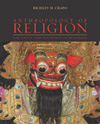
Religious Ritual |  |
Chapter Summary- Rituals are the quintessential religious behavior. They embody important information about ideological and social unity of the group, and participation in rituals is an act that reaffirms this unity to those who already share them.
- Participation in rituals publicly and unambiguously communicates acceptance of the community morality symbolized by a ritual.
- Religious symbols are characteristically multivocal in having many equally valid meanings.
- Religious rituals do not have just one correct meaning. Rather, they express many different meanings simultaneously.
- The purpose of religious rituals is to influence the supernatural. Technological rituals are performed to control various aspects of nature. Therapy and anti-therapy rituals are rituals for influencing the human body. Social control rituals are intended to maintain the stability of society. The purpose of rituals of salvation is to cause a temporary or permanent change in the participant's personality. Revitalization rituals are conducted to help people cope with large-scale societal stresses.
- Religious rituals differ in the degree of anticipated effectiveness. Magical rituals are performed more mechanistically, with more attention to detail and precision in their performance. They are thought of as compulsive in their effect, when they are performed correctly. Petitionary rituals are performed with the intent of influencing supernatural beings. Although their performance is believed to increase the likelihood of a desired outcome, it is understood that the supernatural beings they are intended to influence may choose not to grant that outcome.
- Magical rituals use two symbolic principles, the idea that like produces like or that an effect resembles its cause and the idea that things which have once been in contact with each other continue to act on each other at a distance after physical contact has been severed.
- The enactment of religious beliefs in ritual that imbues those beliefs with a sense of timelessness and sacredness.
- The most sacred beliefs of a religion that define the essential basis for the rest of its ideology, a religion's Ultimate Sacred Postulates, are assertions that cannot be proved or disproved because the claims they have no empirical referents in the world of ordinary experience. A religion's Ultimate Sacred Postulates often play a central role in its liturgical orders.
- Participating in rituals with others helps people achieve a sense of unity called communitas that involves a state of mind in which the usual hierarchical relationships between the members of a group are overcome and individuals perceive themselves as part of a community of equals.
- Rituals are often described as consisting of three phases, (1) a "separation" phase in which participants are taken out of the ordinary setting in which they conduct their mundane life work and enter a sacred setting that is set apart for the ritual, (2) a "betwixt-and-between" called the "liminal period" in which the feelings of the participants are characterized by communitas, and (3) a phase in which participants are reintegrated into their normal social life.
- Religious rituals called rites of passage can facilitate change in the lives of individuals while reinforcing the stability of the social order in which those individuals participate. They are typically performed when individuals pass from one socially-recognized status to another as they progress through the stages of life that are normally experienced within their society, especially at birth, puberty, marriage, and death.
|
|
|